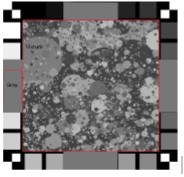Catalog of Regulatory Science Tools to Help Assess New Medical Devices
This regulatory science tool presents a lab method to assess texture reproduction of camera-phone-based medical devices (CPMDs).
Technical Description
This tool is a method that enables users and manufacturers to perform rapid and robust texture reproduction assessment of camera-phone-based medical devices (CPMDs). The assessment method needs a test target below. The exact design of the target might vary. The target has a central texture region (also called the DL region) that consists of a series of overlapping low-contrast discs. The discs have varying radii and uniformly distributed gray levels; giving an accurate stochastic occlusion model that mimics a natural scene. Images of the target will be captures by a CPMD and then averaged to remove noise. The averaged image will then be evaluated for texture loss compared with the target.
Camera-phone-based medical devices represent a major emerging platform for point-of-care diagnostic imaging of biological tissue. However, camera phones lack complex lens systems and large sensors used on digital single-lens-reflex cameras in order to minimize final system weight and manufacturing cost, while still achieving satisfactory performance for consumers. Hardware shortcomings are often compensated with extensive image modifications performed by an image signal processor. Consequently, images captured by a CPMD commonly contain residual noise and artifacts introduced in the image processing steps, which might cause texture loss and thus affect CPMD effectiveness.

Intended Purpose
The tool can be used to compare the amount of tissue texture details lost in images captured by a subject CPMD and predicate CPMD, thus enables, streamlines, or otherwise improves CPMD development.
While the tool was original designed for texture reproduction assessment of CPMDs. It can be extended to any optical imaging medical devices that do not have severe geometric distortion. The tool will be mainly used by an engineer who understand principles of signal processing.
Testing
Described in peer-reviewed publication:
https://doi.org/10.1364/OSAC.2.001863
Limitations
The tool cannot be used for CPMDs with severe geometric distortion since such distortion will change the frequency-domain information in the dead-leaves target.
Supporting Documentation
- This method has been adopted by the IEEE Standard for Camera Phone Image Quality (IEEE Std 1858-2023, https://standards.ieee.org/ieee/1858/6931/)
- The codes package for this method can be found at GitHub (https://github.com/dbp-osel/Camera-texture-reproduction.git). The package encompasses a license file, a manual, a main script, a ‘private’ folder housing subroutines, and an ‘Images’ folder for images slated for analysis, and an ‘outputs’ folder for storing results. Execution of the codes mandates the installation of MATLAB software. Alternatively, users can translate the codes into other programming languages.
- Scientific details about the tool can be found in peer-reviewed publication (https://doi.org/10.1364/OSAC.2.001863).
Contact
Tool Reference
- In addition to citing relevant publications please reference the use of this tool using RST24ES01.01
